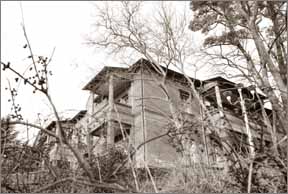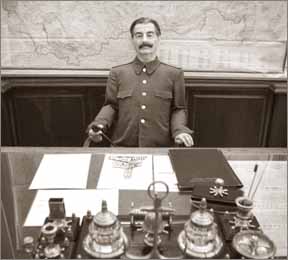|
observer |
|
|
|
|
|
OTHER LINKS |

|

|

|
Stalin's ghost haunts Black Sea hotelTucked behind century-old pines, the austere and sombre green building looks ghostly. A plaque at the entrance reads simply: Stalin's Villa.
Time was when an uninvited visitor would have been terrified to come even close to the so-called Red Tsar's summer residence in southern Russia's Black Sea resort of Sochi. But today, capitalism has triumphed and, for a price, anyone is welcome. The massive dacha - where time seems to be fixed forever in 1937, the year of its construction - is now a hotel where visitors can stay in the one-time holy of holies of Soviet power for up to 390 dollars a night. One can eat in an imposing dining room adorned by the dictator's portrait, swim in his swimming pool and even sleep in his bedroom. Joseph Stalin came here almost every summer. From this peaceful house with shaded verandas, the moustached tyrant supervised socialism's triumphant march, as well as mass repressions and purges. "Here he used to work, smoke, think. From there he would look out to the sea," Valentina Menalan, the villa's manager, said with enthusiasm as she walked from one room to the next. Nothing has changed, she said - the heavy curtains and light wood still recall the 1930s, with only the furniture replaced in the 1960s and 1970s when the villa became a guest house for the Communist Party's foreign visitors. The villa was turned into a hotel after the Soviet crash in 1991.
The swimming pool on the ground floor is still functioning. "Stalin did not like swimming in the sea, so they built him this pool filled with seawater," the guide said. The dacha's dreaded master was also paranoid about his security, so "the dacha is painted in camouflage green, and you cannot see it either from the sea or from the air," Menalan said. Even looking from the top of nearby Akhun mountain, with its breathtaking view of the snowy peaks of the Caucasus mountains and the Black Sea coast, the villa remains invisible. Everything from the height of steps to the pool's depth was adapted to Stalin's relatively small stature - 1.67 metres (5.5 feet), and he would often climb into a high-backed chair to spend hours alone watching movies. The improvised museum holds several personal objects and a billiard table, as Stalin was a great fan of the game. One room has a life-size wax statue of Stalin seated at his table before a silver ink pot presented to him by the late Chinese communist leader Mao Zedong. One thing the Stalin hotel won't remind guests of, however, is the nightmarish side of a totalitarian regime. "There were atrocious repressions, but Stalin also developed industry, space programmes," said Vladimir Shishkin, deputy director of the Zelyonaya Roshcha (Green Grove) hotel complex, which includes the villa. For many Russians, Stalin is the mastermind of the victory over Nazi Germany, source of great national pride, and ruler of an empire that stretched from East Berlin to Vladivostok. Nearly half of Russians - 47 percent - view Stalin in a positive light, with fewer than 30 percent thinking badly of him, a poll published last year by the FOM institute found. For the hotel's visitors, mostly Russians, curiosity and historical interest count above all, not to mention the physical charm of the place, which belongs to a consortium shared by the state, oil giant Lukoil and other Russian firms. Distinguished guests of the hotel have included Russia's Orthodox Patriarch Alexy II, who held a reception here, and China's former Communist Party General Secretary Jiang Zemin. AFP |









